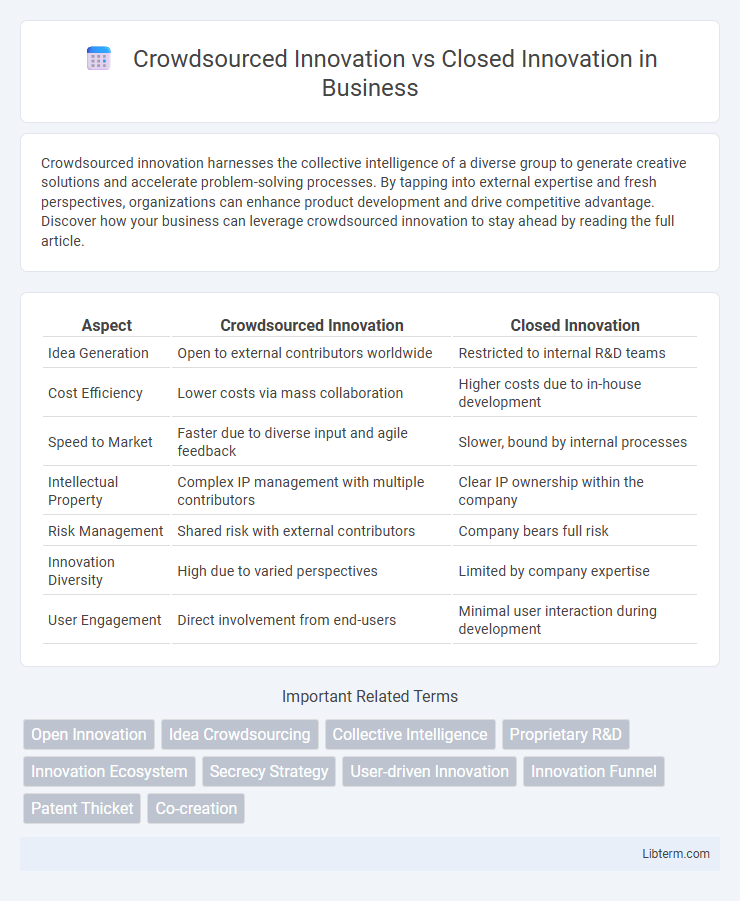Crowdsourced innovation harnesses the collective intelligence of a diverse group to generate creative solutions and accelerate problem-solving processes. By tapping into external expertise and fresh perspectives, organizations can enhance product development and drive competitive advantage. Discover how your business can leverage crowdsourced innovation to stay ahead by reading the full article.
Table of Comparison
| Aspect | Crowdsourced Innovation | Closed Innovation |
|---|---|---|
| Idea Generation | Open to external contributors worldwide | Restricted to internal R&D teams |
| Cost Efficiency | Lower costs via mass collaboration | Higher costs due to in-house development |
| Speed to Market | Faster due to diverse input and agile feedback | Slower, bound by internal processes |
| Intellectual Property | Complex IP management with multiple contributors | Clear IP ownership within the company |
| Risk Management | Shared risk with external contributors | Company bears full risk |
| Innovation Diversity | High due to varied perspectives | Limited by company expertise |
| User Engagement | Direct involvement from end-users | Minimal user interaction during development |
Introduction to Crowdsourced and Closed Innovation
Crowdsourced innovation leverages diverse external contributions from a broad community to accelerate idea generation and problem-solving, harnessing collective intelligence through platforms and open calls. Closed innovation relies on internal R&D teams within an organization, maintaining proprietary control over ideas and development processes to protect intellectual property and ensure focused expertise. Both approaches offer distinct pathways to foster innovation, with crowdsourcing emphasizing collaboration and openness, and closed innovation prioritizing confidentiality and centralized management.
Defining Crowdsourced Innovation
Crowdsourced innovation harnesses collective intelligence by engaging external communities, customers, or diverse stakeholders to generate ideas and solutions, contrasting with closed innovation that relies solely on internal R&D teams. This open collaboration accelerates problem-solving and diversifies input, leveraging platforms like IdeaScale or Innocentive for idea management and validation. Emphasizing transparency and inclusivity, crowdsourced innovation drives competitive advantage through agility and broader knowledge integration.
Understanding Closed Innovation
Closed Innovation relies on internal resources, such as in-house R&D teams and proprietary knowledge, to develop new products or services, ensuring control over intellectual property and competitive advantage. This model limits external collaboration, fostering focused expertise and streamlined decision-making within the organization. Companies like Apple have famously thrived using Closed Innovation by maintaining strict confidentiality and protecting their innovations from competitors.
Key Differences Between Crowdsourced and Closed Innovation
Crowdsourced innovation leverages external contributors, tapping into a diverse pool of ideas from a global community, while closed innovation relies exclusively on internal research and development teams within an organization. Key differences include the openness of idea generation, with crowdsourcing fostering collaboration beyond company boundaries, versus the secrecy and control maintained in closed innovation processes. Crowdsourcing accelerates innovation cycles by integrating varied perspectives, whereas closed innovation emphasizes proprietary knowledge and concentrated expertise.
Advantages of Crowdsourced Innovation
Crowdsourced innovation harnesses diverse perspectives from a global talent pool, accelerating problem-solving and fostering creativity beyond organizational boundaries. Open collaboration reduces R&D costs by leveraging external ideas and resources while increasing solution diversity and market relevance. This approach enhances agility, enabling companies to respond rapidly to emerging trends and customer needs.
Benefits of Closed Innovation
Closed innovation fosters strong control over intellectual property, ensuring proprietary ideas remain safeguarded within the organization. This approach enables deeper focus on long-term strategic goals with dedicated resources, leading to higher quality and consistency in product development. Closed innovation minimizes risks of knowledge leaks and competitive exposure, enhancing overall innovation security and maintaining a competitive edge.
Challenges in Crowdsourced Approaches
Crowdsourced innovation faces challenges such as maintaining data security and intellectual property control while engaging a diverse external crowd. Filtering valuable ideas from large volumes of submissions requires efficient evaluation mechanisms to avoid resource drain. Ensuring participant motivation and managing collaboration across different cultures and expertise levels complicate the innovation process compared to closed innovation systems.
Limitations of Closed Innovation
Closed innovation limits the diversity of ideas by relying solely on internal resources, which can slow down the development process and reduce creative problem-solving. It often results in higher R&D costs and missed opportunities since external expertise and insights are excluded. This approach may also lead to slower market adaptation due to its insular nature and lack of collaborative input from a broader community.
Real-World Examples: Success Stories and Failures
Crowdsourced innovation has propelled companies like LEGO and NASA, leveraging global talent pools to develop breakthrough solutions such as LEGO Ideas and NASA's Tournament Lab, significantly accelerating product development and problem-solving. In contrast, closed innovation remains dominant in firms like Apple, where secrecy and internal R&D efforts have produced iconic products but limited external input, occasionally leading to missed market shifts as seen in Blackberry's decline. Failures in crowdsourcing, such as Quirky's bankruptcy due to insufficient quality control and IP challenges, highlight the risks, while closed innovation faces setbacks from insular approaches exemplified by Kodak's delayed digital transition.
Choosing the Right Innovation Model for Your Organization
Choosing the right innovation model depends on your organization's goals, resources, and risk tolerance, with crowdsourced innovation offering diverse ideas from a broad community to accelerate problem-solving and foster creativity. Closed innovation relies on internal R&D teams to maintain control and protect intellectual property, suitable for organizations prioritizing confidentiality and proprietary advancements. Evaluating factors such as cost efficiency, speed to market, and collaboration capabilities helps determine whether an open crowdsourcing approach or a closed innovation model aligns best with your strategic objectives.
Crowdsourced Innovation Infographic

 libterm.com
libterm.com